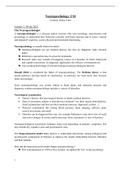Neuropsychology UM
Lecturer: Daina Crafa
Lecture 1: 09 jan 2023
The Neuropsychologist
A neuropsychologist is a clinician and/or scientist who uses neurology, neuroscience and
psychology to understand how behaviors correlate with brain function and to assess ‘normal
and impaired’ cognitive, social, physical and emotional functioning.
Neuropsychology is usually clinical in nature
Neuropsychologists are not medical doctors, but they do diagnostic tasks (clinical
tasks)
Referrals to specialists may be given for treatments
Research tasks may include investigating causes of a disorder, its brain, behavioral
and cognitive processes, its diagnostic approaches, the efficacy of treatments etc.
Uses working knowledge of relevant biological and psychological theories
Donald Hebb is considered the father of neuropsychology. The Hebbian theory is that
neural pathways develop based on experiences, as pathways are used more, they become
faster and stronger.
Early neuropsychology was closely linked to brain injury and dementia research and
diagnosis, modern neuropsychology includes a variety of disorders.
Neurological examination:
Patient’s history, like past surgical history or family medical histories
State of awareness, patient is alert/drowsy/confused? Are there speech abnormalities,
facial asymmetries and how are their emotions (anxious, depressed, restless…)
Physical examination like testing blood pressure, brain imaging, reflexes, pain,
muscle movements and smell
Disorder can be diagnosed this way, for example Parkinson’s may show loss of smell
and motor changes or strokes and lesions may show asymmetry or loss of function
Neuropsychological assessment combines many tests depending on patients’ symptoms, this
may include IQ, cognitive tests and psychometric tests.
The biopsychosocial model helps doctors to understand interactions among biological and
psychosocial components of illnesses to improve the dyadic relationship between clinicians
and their patients.
How did the biopsychosocial model change neuropsychology?
First conceptualized in 1950 by Roy Grinker, he applied the ‘bio’ to the psychology
1
, Proposed as a medical perspective by George L. Engel in 1977, he applied the ‘social’
to the medicine
So the main thought behind the model is that a person is not made of isolated organs, but
functions as a whole. You need good biological, social and psychological circumstances to
have good mental health.
Dementia is an umbrella term for impaired memory, cognition and decision-making, common
causes are Alzheimer’s, Huntington’s disease, multiple sclerosis (MS)
The Neuropsychiatric Inventory (NPI) is used to characterize dementia in the clinic
It assesses frequency and severity of symptoms as well as changes in behavior, for
example monitoring if it is getting worse or not
Biopsychosocial perspective in dementia is usually applied as part of a treatment plan,
external triggers are assessed through history interview, for example one study found that
80% of dementia symptoms had external triggers
Social support and environmental well-being are considered in the treatment plan
Part of our social well-being is our cultural fit, beliefs from our community shape our
experiences of medicine, this perspective helped lead to other social-clinical models
Not all symptoms are symptoms, certain beliefs are cultural, sometimes hallucinations
are even considered culturally appropriate or spiritual
The Cultural Formulation Interview (CFI) is used to determine whether something
is pathological, altered or caused by a disease
What is Broca’s aphasia? A language disorder with loss of
grammatical structure and difficulty with the forming of words and
sentences, a non-fluent aphasia in which the output of spontaneous
speech is markedly diminished.
What is a brain lesion? A brain lesion is an area of damaged brain
tissue, this kind of damage happens because of brain injuries or
medical conditions like a stroke or tumor.
How brain lesions lead to the modern understanding of brain function and organization,
clinical cases (like Broca’s aphasia) led to the discovery that certain types of damage was
consistent with certain types of symptoms:
Localization, damage was in a certain part of the brain, concluded that some brain
functions were anatomically located, specific brain areas control specific behaviors
Lateralization, damage was on a certain side of the head, concluded that some
functions were usually on a specific (one) side of the brain
Distribution of function, lost functions are sometimes rehabilitated, concluded that
other parts of the brain can compensate
Hierarchical organization, sophistication of functions are very depending on
whether a higher or lower brain area is damaged, brain processes start with lower
levels and are processed through increasingly higher levels
2
, Hierarchical organization. Processing begins with lower relevant brain regions (hindbrain)
then moves to higher brain regions (forebrain), loss of function in higher brain regions is
dissolution, meaning that the brain can compensate with lower regions, simplified behaviors.
Hierarchical organization:
The hindbrain, consisting of the spinal cord, brain
stem and cerebellum, it controls vital functions and
was probably evolved first
The midbrain, consisting of the colliculi,
tegmentum and cerebral peduncles, it controls
vision, hearing, motor function, alertness and
temperature regulation, this probably evolved
second
The forebrain, consisting of telencephalon (includes cerebral hemispheres) and
diencephalon (the thalamus, hypothalamus, epithalamus and subthalamus), controls
complex cognitive, sensory and motor activities and probably evolved last
Back to Broca’s aphasia, speech is hard to produce but usually not impossible, other language
functions, like understanding speech and motor movements, as well as production of familiar
songs, often remain intact.
Wernicke’s aphasia (word salad), Wernicke’s area ensures that the language makes sense,
Broca’s area ensures the language is produced in a fluent way. Conduction aphasia, a patient
can’t repeat what is heard, occurs when the connecting speech areas are cut.
Directional terms and anatomical planes:
3





